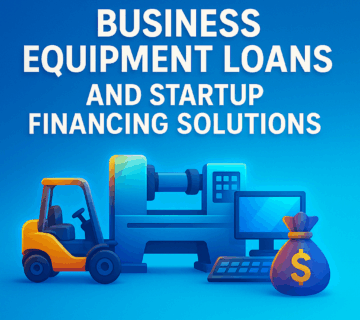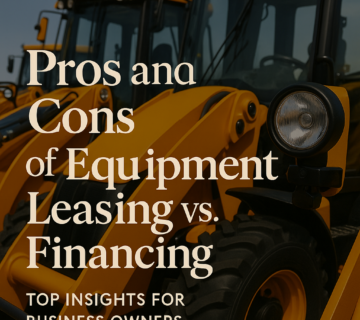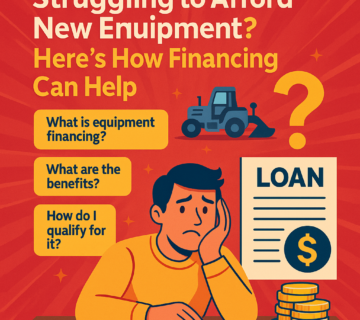2025 Equipment Financing Trends: What Businesses Need to Know

As businesses face an ever-changing financial landscape in 2025, equipment financing has become more than a way to acquire essential tools. It’s a strategic decision that affects growth, cash flow, and operational flexibility. From small companies to large enterprises, understanding the latest trends in equipment financing can help businesses make cost-effective choices that align with their goals. This guide will walk you through the top equipment financing trends and what they mean for businesses in 2025.
Introduction to 2025 Equipment Financing Trends
2025 is a pivotal year for equipment financing as the market adapts to new economic conditions, technology advancements, and regulatory standards. With the continued impact of rising interest rates, businesses need to prioritize flexible and cost-effective financing options. By understanding the emerging trends and aligning with sustainable, digital-first approaches, businesses can gain a competitive edge while managing their assets efficiently.
Key Equipment Financing Trends for 2025
Flexible Leasing Models
Businesses now have access to a range of flexible leasing models, such as usage-based leasing and subscription models. These options let companies adjust payments based on actual equipment use, offering a cost-effective way to meet changing demands.
AI and Automation in Financing
Artificial intelligence (AI) and automation have become central to financing, simplifying application processes and enabling quicker approvals. AI-powered systems can assess risk, customize offers, and predict financing needs based on historical data, creating more personalized and accessible options for businesses.
Green Financing Options
As part of the global shift toward sustainability, green financing options are more widely available. Companies investing in eco-friendly equipment—like electric vehicles or energy-efficient machinery—can secure financing with favorable terms, reducing costs and supporting ESG commitments.
Sector-Specific Trends
Healthcare
In healthcare, equipment financing remains crucial due to the high costs of advanced medical equipment. Flexible financing and leasing options are popular as healthcare providers look for ways to incorporate cutting-edge technology without high upfront costs.
Manufacturing
The manufacturing industry increasingly relies on equipment leasing to combat rising material costs and obsolescence. Short-term, renewable leases are popular in 2025, allowing manufacturers to upgrade equipment frequently without long-term commitments.
Technology
With rapid advances in the tech sector, companies are leaning toward leasing rather than purchasing equipment. Equipment-as-a-Service (EaaS) models are particularly popular, providing tech firms with scalability and cost predictability.
Digital Transformation in Equipment Financing
Digital tools are revolutionizing financing processes by reducing paperwork, speeding up approvals, and automating payment tracking. With cloud-based platforms and e-signature capabilities, companies can secure financing quickly and with less manual effort, improving the borrower experience and lender efficiency.
Small Business Financing Strategies
Small businesses often face cash flow constraints and benefit from short-term leases or equipment leasebacks—where assets are sold to a lender and leased back. Partnering with lenders who specialize in small businesses can also lead to faster approvals and more flexible terms.
Short-Term vs. Long-Term Leasing
Short-term leases offer flexibility and are ideal for industries with seasonal demands or frequent equipment updates. Long-term leases provide stability, often at lower rates, suitable for businesses with consistent equipment needs. Evaluating specific requirements can help businesses choose the best term length.
How ESG Factors Affect Equipment Financing
Environmental, Social, and Governance (ESG) standards are increasingly influencing financing options. Companies adhering to ESG principles can access green financing options that offer lower rates and more favorable terms for investments in eco-friendly equipment, such as energy-efficient technology or zero-emission vehicles.
How Rising Interest Rates Impact Equipment Financing
Interest rates have risen in 2025, making equipment financing more costly. Fixed-rate financing provides predictability and stability, while businesses should also consider interest rate caps or adjustable rates that align with their risk tolerance and financial strategy.
Choosing the Right Financing Model
To select the right model, businesses should:
- Determine equipment needs and financial goals.
- Evaluate leasing vs. financing options.
- Analyze costs (interest, fees, terms).
- Compare lender offerings for interest rates and payment flexibility.
- Consider growth and scalability needs.
AI and Big Data in Financing Decisions
AI and big data are essential tools for lenders, helping with risk management and customized solutions. With predictive analytics, lenders can understand trends, assess clients’ financing needs more accurately, and provide smarter, more tailored solutions for borrowers.
Top Lenders for Equipment Financing in 2025
The top lenders in equipment financing offer tailored options and competitive terms. Leading companies include:
- Bank of America – Known for diverse financing solutions and competitive rates.
- CIT Group – Specializes in quick approval processes for small-to-medium businesses.
- Wells Fargo Equipment Finance – Offers industry-specific options with flexible payment plans.
Future of Equipment Financing: Predictions for 2025
The future of equipment financing includes increased use of blockchain for secure, transparent transactions, the expansion of green financing options, and further integration of AI. Predictive financing will continue to evolve, offering businesses solutions that adjust with their growth and operational changes.
Frequently Asked Questions
1. What are the best funding choices for small business?
Short-term leases and equipment leasebacks are ideal for small businesses, especially when working with lenders specializing in quick approvals and flexible terms.
2. How do rising interest rates affect equipment financing?
Higher rates increase financing costs, making fixed-rate options appealing for businesses seeking stability in their budgets.
3. Are there benefits to financing sustainable equipment?
Yes, businesses investing in sustainable equipment often have access to green financing with lower interest rates and tax incentives.
4. What role does AI play in equipment financing?
AI supports better decision-making for lenders, enabling them to offer tailored solutions while providing faster approval and enhanced risk management.
5. Should my business lease or buy equipment?
This depends on your cash flow, equipment requirements, and long-term plans. Leasing provides flexibility, while purchasing may be better for long-term assets.
6. How does digital transformation impact equipment financing?
Digital platforms speed up application and approval processes, allowing for a more efficient experience with automated payment tracking and e-signatures.
Conclusion
In 2025, businesses face both challenges and opportunities in equipment financing, from rising interest rates to digital transformation and ESG considerations. By staying informed on the latest trends, businesses can make smarter decisions to optimize cash flow and drive growth. Flexible leasing models, green financing, and AI-driven tools can enhance how companies manage assets, making this an exciting time to explore equipment financing.




No comment